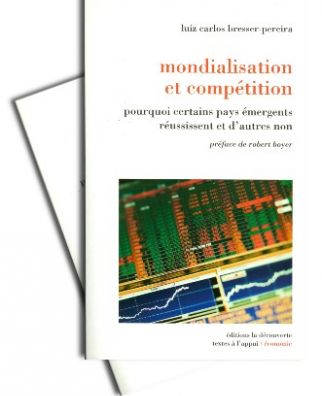2014, with Pedro Rossi. The euro crisis is a internal exchange rate crisis; austerity is a costly and inhuman policy of internal depreciation. (paper, in the Journal of Post Keynesian Economiscs)
NEW-DEVELOPMENTAL THEORY (NDT)
ND - ECONOMICS - BASIC TEXTS
2014. In developing countries it is not enough to secure demand for entrepreneurs to invest; additionally, is required access to it, which only a competitive exchange rate can assure. (Paper Keynesian Brazilian Review)
2012. In this paper I finally defined the relation between the exchange rate and the investment rate (and so, the growth rate). Investment depends on the exchange rate because as the theory says that it tends do become overvalued in the long-term (for several years) within the exchange rate cycle, companies will take this overvalued currency as reference in their investment decision and will refrain from investing (Paper: Estudos Avançados) English version
2012. In this paper I finally defined the relation between the exchange rate and the investment rate (and so, the growth rate). Investment depends on the exchange rate because as the theory says that it tends do become overvalued in the long-term (for several years) within the exchange rate cycle, companies will take this overvalued currency as reference in their investment decision and will refrain from investing (Paper: Estudos Avançados) Portuguese version
2011. My more complete paper on new developmentalism. In José Antonio Ocampo and Jaime Ros, eds. Handbook of Latin America Economics, Oxford: Oxford University Press. (Paper). Portuguese version available.
2010. In Globalization and Competitiion, behind the "new developmentalism" (a national development strategy) there is a "structuralist development macroeconomics" . (Note to be published in this website)
2010. Why some middle income countries catch up while others do not. Behind new developmentalism this book drafts a structuralist development macroeconomics in which the exchange rate plays a strategic role. (Book: Cambridge University Press).In the bookstores and in kindle
2010. Why some middle income countries catch up while others do not. Behind new developmentalism this book drafts a structuralist development macroeconomics in which the exchange rate plays a strategic role. (Book: Siglo XXI). Avaliable here in pdf format.
2009. Why some middle income countries catch up while others do not. Behind new developmentalism this book drafts a structuralist development macroeconomics in which the exchange rate plays a strategic role. (Book: Éditions La Découverte) In the bookstores.
2009. Why some middle income countries catch up while others do not. Behind new developmentalism this book drafts a structuralist development macroeconomics in which the exchange rate plays a strategic role. (Book: Elsevier).Disponível nas livrarias
2008. A country suffering from the Dutch disease has two "equilibrium" exchange rates: the "current equilibrium" that is inconsistent with economic growth, and the"industrial equilibrium" that will be achieved if the country is able to neutralize the disease. (Paper in edited book) English version published in Brazilian Journal of Political Economy)
2008. The manufacturing industry is growing while it is prematurely desindustrializing due to moderate but not neutralized Dutch disease. (Article: Folha de S.Paulo).
2007. An encompassing analysis of the Brazilian macroeconomic system. A first presentation of the developmental macroeconomics. Why Brazil failed to grow fast after the Real Plan. (Book: Editora 34) Out of print; availble in this site. English version available: Developing Brazil (2009).
2008. With Paulo Gala. An overvalued currency is a central cause of insufficiency of demand. The growth with foreign savings policy appreciates local currencies, increases domestic consumption, and causes domestic saving to be replaced by foreign savings. (Paper Journal of Post Keynesian Economics).
2007. With Paulo Gala. A formalization of the critique of the strategy of growth with foreign savings: the consequent exchange rate appreciation increases artificially wages and causes the substitution of domestic with foreign savings. English version available.(Paper: Revista de Economia Política)
2007. Paper comparing three growth strategies: old or national-developmentalism, new developmentalism, and Washingtons conventional orthodoxy - actually a form of neutralizing the catching up of medium income countries. Portuguese and English versions available. (Paper: Economía Unam)
2007. Paper comparing three growth strategies: old or national-developmentalism, new developmentalism, and Washingtons conventional orthodoxy - actually a form of neutralizing the catching up of medium income countries. English and Spanish versions available. (Paper: Revista São Paulo em Perspectiva)
2006. Paper comparing three growth strategies old or national-developmentalism, new developmentalism, and Washingtons conventional orthodoxy - actually a form of neutralizing the catching up of medium income countries. An improved version available with the title "Macroeconomics of stagnation and new developmentalism".(Paper Economie Appliquée).
2005. The perverse macroeconomic model of the Brazilian economy combining high interest rate and low exchange rate with growth with foreign savings and quasi-stagnation. (In edited book, Novo Desenvolvimentismo)*
2003. The perverse macroeconomic model of the Brazilian economy combining high interest rate and low exchange rate with growth with foreign savings and quasi-stagnation. (Paper: Análise Econômica)*



























